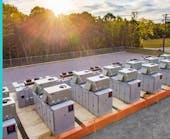The ubiquitous yellow school bus is going electric—and with good reason. Electric school buses offer myriad advantages over traditional fuel sources, from zero tailpipe emissions and less noise, to lower operating and maintenance costs. Plus, now there’s the emerging opportunity for buses to help meet demand for electricity, using an innovation called vehicle-to-grid (V2G) technology.
Outfitted with V2G, the school buses have the potential to store surplus energy produced from intermittent solar or wind sources and then feed that energy back to the grid in response to demand or lower supply. Armed with that capacity, school buses could provide the grid with bulk energy storage, peak-shaving services, operating reserves, and regulation and ancillary services. Imagine the possibilities if the school bus industry were to really harness all this.
On average, a school bus is used just four hours a day to ferry kids to and from school. But outfitted with a battery and bidirectional inverter, the bus – which would otherwise languish for 20 hours – can then be harnessed to absorb and store excess generation from the grid, supply power back to the grid, and provide other electricity products to maintain its reliability.
Although the yellow school bus industry has made significant strides to use cleaner technology, most buses still run on diesel fuel. This is unsurprising considering that making the initial investment in cleaner electric equipment and charging infrastructure can be prohibitive for some school districts and communities. That hurdle is, however, becoming easier to overcome as partnership opportunities have begun to emerge with public utilities looking to offset peak demand and state governments endeavoring to reduce emissions. Those stakeholders see the value in an electric school bus’s large, resilient battery and availability for use beyond just transportation. Indeed, most buses probably remain parked during the summer months, making them ideal for energy storage and power sales back to the grid.
So, who can benefit from the electric bus? School systems, local communities, and states should all view it as a valuable opportunity. Bus manufacturers and public utilities are helping lead the way. Transportation is the number one source of carbon emissions in the U.S. According to Dominion Energy, replacing one diesel bus can reduce greenhouse gas emissions by 54,000 pounds each year (that’s the equivalent of 3.75 pounds of carbon dioxide for every mile driven), and the air quality inside an electric bus is six times better than a diesel bus.
Moreover, electric buses are quieter, allowing for the driver to have better communications with students. And, an electric bus can reduce operation and maintenance costs for schools by as much as 60% compared to a diesel model. Electric buses get the equivalent of 17 miles per gallon (MPG) compared to 6 MPG for diesel.
All these positives mean schools, local communities, and states will undoubtedly benefit. Exposure to tailpipe emissions obviously affects children’s respiratory health, and decreasing such exposure has been shown to improve test scores. There are also updated safety features in newer electric school buses, as well as the potential for Wi-Fi-enabled buses to help bridge the broadband divide.
Shifting to electric school buses would also benefit the grid. Even with our technological advances, it is an ongoing challenge to economically store electricity. Electricity must be produced constantly so that supply and demand always balance—otherwise, we get blackouts and load-shed events. California, for example, is currently experiencing a heat wave that has forced the grid operator to use rolling outages in order to prevent a catastrophic outage. During a power outage or emergency, the batteries on a school bus can serve as mobile power stations. And, using batteries and other storage resources helps the grid operator avoid using fossil fuel-fired generation to both meet peak demand and supply the ancillary services used to stabilize the grid.
Such potential for energy storage also helps to mitigate one of the issues that inhibits larger-scale adoption of renewable energy—intermittent supply. Changes in weather mean changes (often sudden drops) in wind and/or solar generation. Rather than relying solely on fossil fuel-fired generation, grid operators may now look to an electric school bus fleet to help stabilize the grid by storing and providing energy when peak demand spikes or when renewable generation drops off. Conversely, sometimes, renewable generation and other generation resources wind up in oversupply, thus generating more electricity than demand can absorb. Battery storage offers the grid operator an economical way to draw energy from that oversupply to store for future use.
As with other sparkly emerging technology, there are detractors to the electric school bus idea. Many note that switching from gasoline or diesel to electricity may result in utilities facing difficulty in managing changing load shape. Replacing conventional vehicles with electricity-powered ones may offer efficiency gains on a Btu/mile basis, energy cost savings, and reduced environmental impacts, but obviously would lead to increased demand for electricity and need for charge-points. However, detractors argue the increased consumption of electricity may conflict with the goals for carbon-free electricity generation. And, this increase in consumption of regulated energy may be an issue for states that have decoupled utilities’ revenues from energy usage.
The electric school bus can also offer tremendous opportunity for uninterrupted transitioning to microgrid “islanded” operation. In some instances, an interruption of power supply can pose a significant risk to critical operations or other lost value. In such circumstances, a storage system can act as a fast-response system to provide instant power to a microgrid during a potential outage period. Even once the transition to islanded operation is satisfied, a storage system with on-site generation can act to sustain the microgrid’s operating duration by producing and absorbing power in response to the microgrid’s evolving commands. Thus, to successfully island demand, a storage system needs to be coupled with a source for supply. Electric school buses, fit with bi-directional, resilient inverters, can offer a means for such supply.
For all this innovation to succeed, regulators will need to be mindful to avoid creating a quagmire about the role of electric vehicles in our wholesale energy markets. Regulatory hurdles and jurisdictional malaise could stifle development, strand costs, and impede realization of the full potential V2G technology offers. Strong leadership thus far from the Federal Energy Regulatory Commission (FERC) and several states offers solid building blocks for a coherent platform on which schools and states can build.
Recent decisions by FERC will now allow for more rapid adoption of battery-powered school buses as energy storage resources. FERC’s Order 841 takes steps toward removing barriers that inhibit energy storage resources from more fully participating in wholesale energy markets. FERC has also recently approved the use of energy storage as a transmission resource—in addition to being a generation resource—which paves the way for such storage resources to establish cost-based rates, rather than competing for market-based rates.
These are exciting times for moving our electricity system toward the resilient, dependable system we all need in today’s hectic, threat-prone environment. Electric school buses—big yellow rolling batteries—offer a practical way to help meet those challenges.





